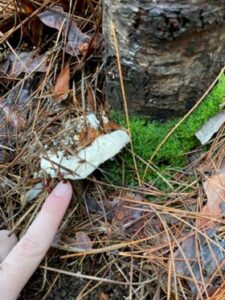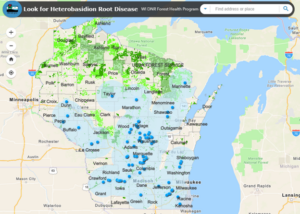By Alex Feltmeyer, Forest Health Specialist, Plover, Alexandra.Feltmeyer@wisconsin.gov or 715-340-3810

A Heterobasidion root disease fruiting body is found at the base of a white pine sapling in the understory. Photo: Wisconsin DNR Forest Health
Heterobasidion Root Disease (formerly annosum root rot or Fomes root rot) is a serious disease of conifers that causes reduced height, shoot and diameter growth along with thin and yellowish/red foliage, ultimately causing mortality.
The disease becomes established in a new stand when spores of the fungus land on freshly cut stumps made by any forest management that creates cut stumps. After the disease becomes established, it spreads underground through root systems into adjacent trees. In this way, we often find pockets or groups of trees in various stages of decline.
Movement through the root systems contributes to significant spread throughout stands of conifers, impacting the regeneration of conifers within these pockets.
Mortality usually starts occurring three to eight years after a thinning operation. During this time, perennial fruiting bodies of the fungus begin to develop around the base of cut stumps or dead trees.
Due to the severity of the disease and the most likely mode of transmission through cut stumps, preventative guidelines were developed and implemented in 2018. The HRD guidelines were developed to help property managers and landowners determine whether preventive pesticide treatments should be used to reduce the risk of introducing and spreading HRD during harvest in a pine and/or spruce stand.
The best management for most forest pathogens is prevention. Prevention of HRD includes targeting the freshly cut stumps that the spores land on to prevent establishment of the disease in new areas. What does this look like? Currently, two types of pesticides are approved in Wisconsin to prevent HRD from infecting freshly cut stumps within a stand.
The first is a biological control agent called RotStop C®. This product contains spores of a naturally occurring and native wood decay fungus, Phlebiopsis gigantea, which outcompetes HRD to colonize the cut stump. The second is a borate compound called Cellu-Treat™. This product acts as a wood preservative and barrier to prevent spore germination.
Both products are applied using a water solution and can be applied using a spray attachment on a processor during harvesting operations or using a backpack/hand sprayer. Stumps should be sprayed during forest management activities in pine stands from April 1-Nov. 30. Spraying liquid products is most feasible during that timeframe.
Who should be spraying stumps, and where? The DNR Forest Health team has developed an interactive web map to display currently known infections of HRD and to inform managers of all land types whether they should apply preventative stump treatments based on their stand location.

An interactive web map to identify areas where stump application of pesticides is recommended. Photo: Screenshot from Wisconsin DNR Forest Health webpage
The map displays known HRD location points within 25-mile buffer zones. If your stand is located inside the 25-mile buffer, applying a preventative treatment to stumps is highly recommended. The map is updated annually on Jan. 1 and is valid through the end of the year. It should be consulted at the time of timber sale establishment.
How is HRD best managed once it is in a stand? Appendix A of the HRD Guidelines addresses the generally accepted forestry management practices used to manage HRD:
1) Always start thinning or harvesting in the healthy (non-infected) portions of the stand and move into the infected areas.
2) During thinning or salvage operations from April through November, utilize the dead trees and bottom 8 feet of trees, showing dieback as soon as possible.
3) The fungus moves through root systems at approximately 3.5 to 6.5 feet per year, resulting in an estimated expansion of 35 to 65 feet in 10 years between thinnings. Once the last symptomatic trees have been identified on the outskirts of a pocket, sacrifice all healthy trees within 35 to 65 feet if the next thinning is scheduled in 10 years.
4) A clearcut may be considered if the infection is extensive.
5) Clean all logging equipment before departure from the harvest site.
What else can make conifers die in Wisconsin? Other organisms in Wisconsin cause mortality to pine and spruce, which can often be mistaken for HRD.
Red pine pocket mortality and decline is caused by bark beetles that carry a fungus that creates blue stain in conifers. This combination of pests can cause pockets of declining pine in plantations that closely mimic infection by HRD. Foliar fungal pathogens, insects and abiotic issues can also mimic symptoms of HRD.
It is crucial to seek positive or negative confirmation through laboratory testing. As always, please call your local Forest Health Specialist for assistance in diagnosis and management.
If you have any questions about HRD, please contact your Regional DNR Forest Health Specialist.
